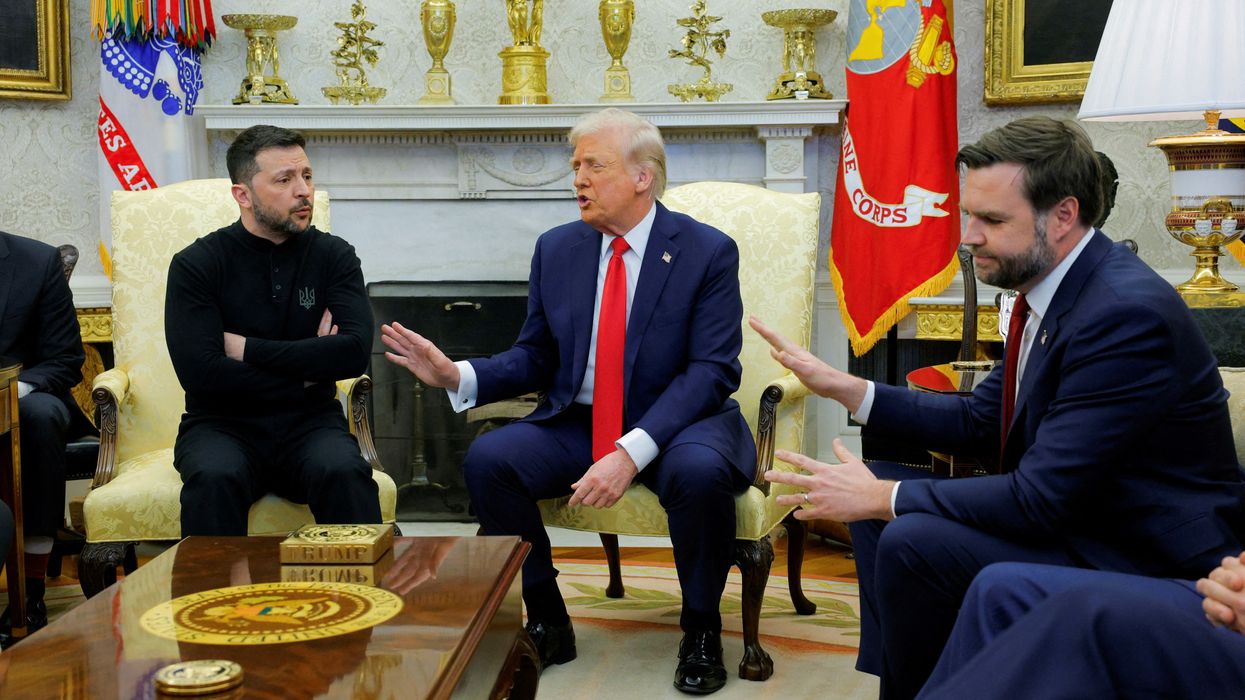Scientists and doctors have been warning of a global pandemic for years, but it wasn’t until the novel coronavirus had spread from China to South Korea, Iran, Italy, and beyond that it became clear we weren’t prepared.
As late as March 9, President Trump was blaming Democrats and “the fake news media” for inflaming the coronavirus situation. Three weeks later, most of America was on lockdown, the U.S. death toll was approaching 5,000, and Department of Homeland Security officials announced the federal government stockpile of personal protective equipment — masks, gloves, and gowns, etc. — was nearly depleted.
Just as the world was ill-prepared for COVID-19, it also is not equipped to respond to the calamity that would follow even a “limited” nuclear strike that could kill millions in the first week.
At the same time the coronavirus was infecting people across the planet, the Trump administration was calling for sharp spending increases to modernize the U.S. nuclear arsenal. In February the Pentagon and announced its deployment of a new low-yield submarine launched nuclear weapon in early February. At the same time, Trump wants to build thousands of plutonium pits for nuclear bombs and is fast-tracking replacement of America’s ICBM stockpile.
Use of any one of these weapons would almost certainly dwarf COVID-19 deaths at an unimaginable scale and speed. The human cost of nuclear weapons has been known since 1945, but the shock and raw horror has faded from public consciousness. A 1995 World Health Organization report entitled “Health and Environmental Effects of Nuclear Weapons: serves as reminder: “[B]esides the catastrophic effects in terms of deaths, causalities, and material damage,” the WHO says, “the use of nuclear weapons will cause human suffering and environmental disturbance on an unprecedented scale.”
Warning signs
Unlike presidents and generals who view nuclear weapons as the ultimate power tool of statecraft, doctors see them as blunt tool of mass murder. Dr. Ira Helfand, an internist and urgent care physician in western Massachusetts says the time to heed warnings of an accidental or intentional use of nuclear weapons as long overdue. The coronavirus pandemic, he says, should be our wake-up call.
“I think the really big lesson for us to learn from this is that when scientific experts tell us something really terrible is going to happen if we don’t take action, we need to listen,” Helfand said.
Helfand, co-president of International Physicians for the Prevention of Nuclear War, said that the impacts of the coronavirus, while substantial, are a “tiny, little thing” compared to what would follow a nuclear war. Both threats, he said, are blueprints of unpreparedness.
“We’re trying to write this on the back of an envelope as we ride into battle and it isn’t working,” Helfand said.
“We didn’t have the materials…we didn’t have a plan in place…there’s no infrastructure in place to deal with this kind of crisis and there could have been if we’d taken the warnings from the medical and scientific community seriously.”
Pointing to the global anti-nuclear movements of the 1980s which helped end the Cold war, Helfand says ordinary people everywhere need to play a much more active role in pressuring governments to avoid what he called a “preventable catastrophe.”
Dumb luck
Alexandra Bell, a senior policy analyst at the Center for Arms Control and Non-Proliferation, said the coronavirus pandemic lays bare mismanaged national security priorities that assume a strong, well-equipped military is the key to security.
“The real problems we’ve faced over the last decade have been natural disaster related to climate change [and] economic upheaval. It’s been attacks on democracy and the rise of populism, it’s been pandemics. Nothing in the nuclear budget is helping any of those problems,” Bell said.
The pandemic, Bell hopes, will illustrate how capable, resilient responses require expert, non-partisan experts and threat assessments, and a government that hasn’t been winnowed down to a state of ineffectiveness.
She sees the need to reassess spending priorities, a more vigorous Congressional debate over nuclear weapons, and a renewed commitment to the hard, tedious work of reducing nuclear threats.
“I hope that people see a $750 billion defense budget did nothing to stop the spread of this deadly virus across the country,” Bell said.
What’s more, Bell argues that no country is prepared for the aftermath of a nuclear conflict. “The panic, the absolute political and economic chaos that would follow such an exchange — there’s no way to prepare for that.” The fact that it hasn’t happened in 75 years is largely a matter of luck. “The longer we go, the more likely is that our luck will run out,” Bell said.
America’s worst day
Operating from Offutt Air Force Base on the Nebraska-Iowa border, U.S. Strategic Command (STRATCOM) oversees command and control of America’s strategic nuclear weapons. STRATCOM was built to survive and operate for long periods, even on “America’s worst day”—after a nuclear attack.
STRATCOM is part of a network that assumes to provide a nuclear deterrent for not only the U.S. but also over 30 allies around the world. In the event deterrence fails, STRATCOM is prepared to respond by air, land, sea, space, and cyber — and could include nuclear weapons. The U.S. maintains a total inventory of nearly 6,000 nuclear weapons.
“Our number one job is providing a strategic deterrent… to literally deter other countries from using [nuclear weapons] against us,” a STRATCOM spokesperson said. “That’s our number one priority… to actually prevent the use of these weapons.”
Overwhelmed, underprepared
Stephen Young, a senior Washington representative with the Union of Concerned Scientists, said the world is unprepared to respond to the use of atomic weapons. “In a nuclear war, you can’t ramp up. You have to be ready now.”
But unlike a virus which doesn’t damage buildings or infrastructure, even a comparatively small nuclear bomb with a yield of 10-20 kilotons (similar to the bombs that destroyed Hiroshima and Nagasaki) would cause enormous localized damage, all but ensuring the inability to adequately respond.
Based on a Pentagon model, the Union of Concerned Scientists produced this short video simulating the fallout patterns and casualty rates in the event of the U.S. dropping a one megaton bomb in central Iran. Over 3 million people would be killed with tens of millions injured or exposed to radiation as far away as India, Pakistan, and Afghanistan.
Citing the trillions of dollars the U.S. spends to build, maintain, and modernize a nuclear arsenal it hopes to never use, Young said, “We are fully prepared to wage nuclear war. We are not fully prepared to respond to it, the same way we are not prepared to respond to this virus.”
Like the coronavirus, people don’t like thinking about nuclear weapons. That’s according to Prof. Alex Wellerstein, a historian of science at the Stevens Institute for Technology. He contends however, that if people are only thinking about nuclear weapons during a crisis, it’s too late.
“You have to plan these things out… well before they’re on your doorstep,” Wellerstein said. The nuclear threat is complicated by the fact that nuclear weapons are seen through the lens of nationalism — American weapons versus Russian or Chinese weapons versus Indian weapons.
“Should we take a lesson from pandemics and start conceptualizing these existential risks in non-national terms? Of course we should,” Wellerstein said. “This is what everyone who works on existential risks will tell you, but they’re not in charge of anything at the moment.”
Our failure to meet even the basic demands of a pandemic response — providing enough personal protective equipment, widespread, accessible testing — should give us pause, Wellerstein said, adding that the coronavirus has exposed the consequences of failing to adequately plan for low probability, high consequence risks.
Always never
One institution that prides itself on being trained to respond to high consequence risks is Sandia National Laboratories, one of the three main Department of Energy labs that support designing America’s nuclear weapons. In a written statement, Sandia said, “As stewards of the nation’s nuclear stockpile, Sandia constantly considers the immense responsibility to ensure nuclear weapons always work if called upon by the president and never otherwise.”
The statement continued, “There are striking differences between the hazards of a virus and radiological material that make the two scenarios difficult to compare. The new coronavirus does not travel in a plume or have the same kind of epicenter as a nuclear detonation would. Radiological material does not replicate as it spreads, but rather dilutes.”
While radioactivity dissipates as it spreads over time, one of the most dangerous potential consequences of nuclear war is nuclear winter, a concept dating back to the early 1980s.
Alan Robock, a distinguished professor in the Department of Environmental Sciences at Rutgers University, has been studying nuclear winter for more than 30 years and continues this research.
In this 2013 TEDx Talk, Robock described how a nuclear war between India and Pakistan would kill millions with detonations producing 5 million tons of smoke that would rise into the atmosphere, block the sun, cool and dry the planet for up to a decade, triggering global crop failure, famine, and death on an incomprehensible scale.
In 2019, Robock was the lead author of a study published by the Bulletin of Atomic Scientists that examined the global consequences of a nuclear war between Indian and Pakistan that could kill between 50 and 125 million people and cause profound climate disruption.
In this seventy-fifth anniversary year of the atomic bombings of Hiroshima and Nagasaki, Robock pushed back against modernizing nuclear arsenals. “It’s sort of a very attractive thing to people who think more and bigger weapons somehow make them safer, but they don’t. I hope it doesn’t require another nuclear war to shock people into the horrors of it.”
Sick, dead, and dying
Dr. Ruth Mitchell is a neurosurgeon in Melbourne where she’s also co-chair of the International Campaign to Abolish Nuclear Weapons (ICAN) Australia. Mitchell sees nuclear weapons as a two-fold health threat: when used, they incur mass casualties. When not used, the cost of developing and maintaining nuclear weapons robs people of money and resources that could be used to support stronger, more widely available healthcare.
Speaking at the end of her morning shift conducting urgent operations, Mitchell noted that, like the coronavirus, nuclear weapons can alter life as we know it. But unlike the coronavirus, for which no vaccine currently exists, a pathway to a world free of nuclear weapons does. Failing to redouble efforts to eliminate those weapons, she said, is to “profoundly dishonor the victims of nuclear weapons and testing, and the decades of suffering by nuclear survivors.”
Mitchell initially hesitated to compare the suffering caused by the coronavirus to that of nuclear weapons. “It’s not the Olympics to see who can suffer the most or what would be the worst scenario,” she said, but noted that the devastation, disconnection, and disruption to daily life during the pandemic offers a glimpse of what we can expect after a nuclear weapon is used.
“It should sober us into action on what is an incredibly preventable cause of loss of life and livelihood,” Mitchell said. “What we’re seeing with the coronavirus is just the tip of the iceberg of the amount of sick and dying and dead people that we would see in a nuclear war.”
















